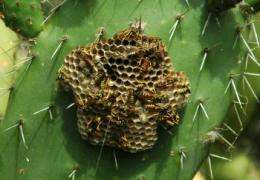How unrelated wasps succeed by helping others breed

(PhysOrg.com) -- Why do some animals help to rear the young of an unrelated individual without any apparent benefit to themselves?
Animals that choose not to reproduce, but instead help non-relatives to breed, represent a challenge to evolutionary theory. How do these animals pass on the genes that make them so altruistic, if they are not breeding themselves or rearing genetically-related offspring? Shouldn't these genes be removed by natural selection?
It's an evolutionary puzzle that University of Sussex research may now have shed new light upon through studying the reproductive behaviour of the paper wasp (Polistes dominulus).
According to Inclusive Fitness Theory, social animals can benefit in the reproductive stakes even if they don't breed themselves by helping to rear offspring produced by a related female, such as their sister or mother (ie social insects such as bees). This is because the offspring of these relatives will be their brothers and sisters, or nieces and nephews, and so will share at least some of their genes.
The paper wasp, however, does not fit this model, because wasps often help non-relatives to breed*. A relatively primitive species, the paper wasp sometimes rears its own young in a solitary nest, but often forms a social nest with other individuals, where one egg-laying female is dominant and the other wasps assist in rearing the offspring. Why would unrelated wasps help their competitors instead of breeding for themselves?
Professor Jeremy Field's and Dr. Elli Leadbeater's findings, published in the journal Science today (Friday 12 August 2011), suggest that the incentive to cooperate lies in the potential to inherit nests, something that has been little investigated in the social insects.
They found that unrelated subordinate wasps are more successful than lone wasps in producing offspring, because they can sometimes rise up the ranks and become the dominant, egg-laying female.
For a paper wasp, therefore, "selfless" effort in the nest of others could pay off in the longer term. If a wasp "inherits" a nest, she will be able to lay her own eggs and have them reared by the nest's workforce. This does not happen in social insects such as honey bees, where subordinates (or "workers") can never become queens.
Dr. Leadbeater and Professor Field observed wasp behaviour in over 200 individual nests in Spain, where colonies can be found nesting in the prickly pear hedges of the Costa de la Luz.
More than 1000 wasps were monitored over a five-month breeding period. The wasps were tagged with paint marks and DNA-tested (to work out which were unrelated to their nestmates) before being returned to their nests. The team then observed which wasps were egg-laying and which were leaving the nest to forage, to work out which wasps were subordinate. At the end of the breeding season, pupae removed from the nests were DNA-matched with parent DNA harvested previously.
According to Professor Field and Dr. Leadbeater, the results show that there is relative benefit for unrelated wasps to be in a social nest, because even though the chances that they will inherit the nest are low, if they are lucky enough to inherit they will produce many offspring. On average, any subordinate in a group will do better than any wasp that tries to breed alone.
Professor Field says: "The behaviour of this primitive insect can therefore be explained by the importance of nest inheritance. Our study shows that paper wasp behavior does fit in with evolutionary theory, but in a different way to other social insects."
Dr. Leadbeater, who is now a Research Fellow at the Zoological Society of London (ZSL),, says: "These unrelated wasps were an evolutionary puzzle, because they seemed to help other wasps that they should be competing with, for no reward. Now we know that they are rewarded in the long term, through inheriting large nests and workforces that they could never have produced alone."
More information: 'Nest inheritance is the missing source of direct fitness in a primitively eusocial insect', Science, August 2011, Ellouise Leadbeater, et al.
Provided by University of Sussex

















